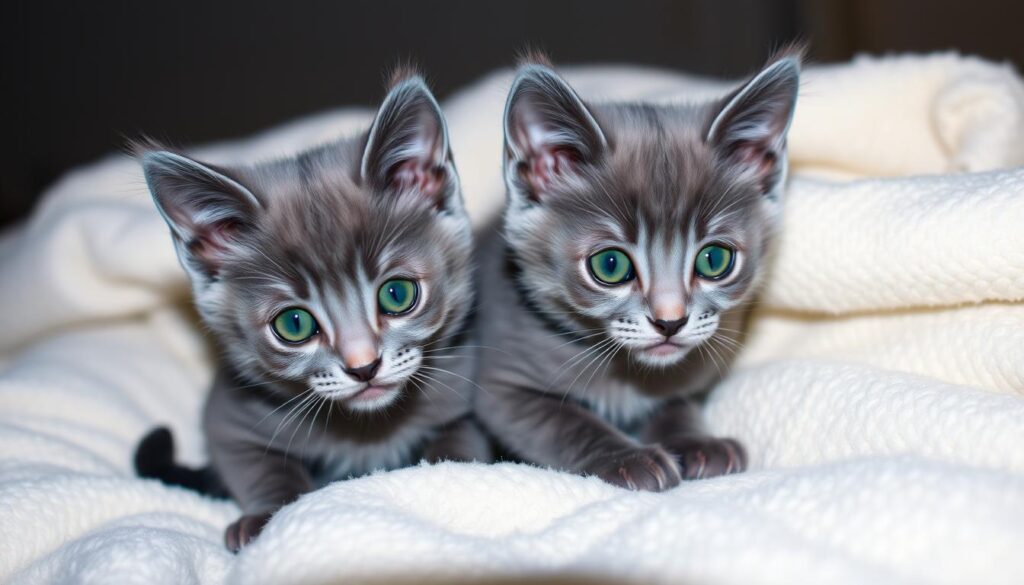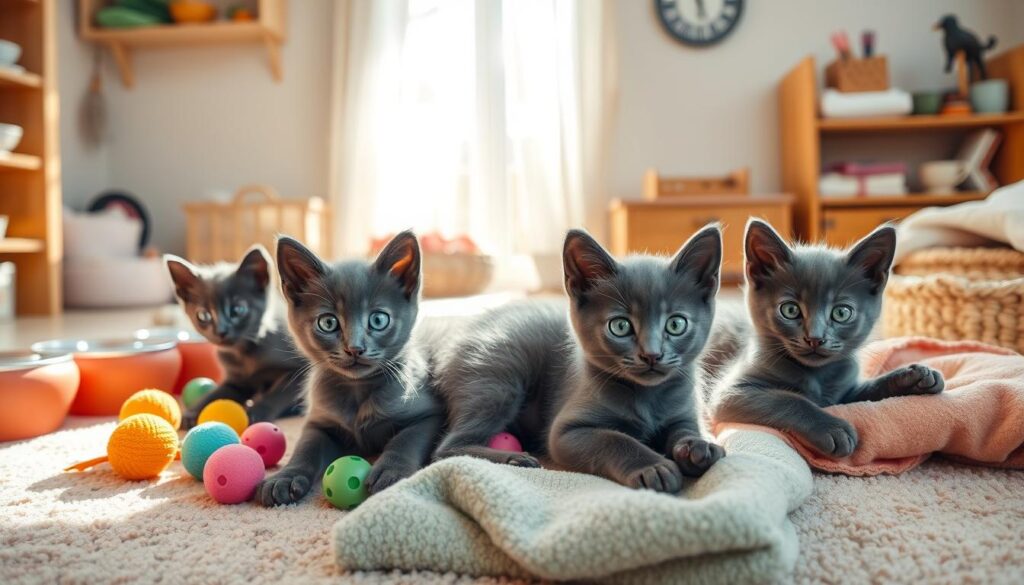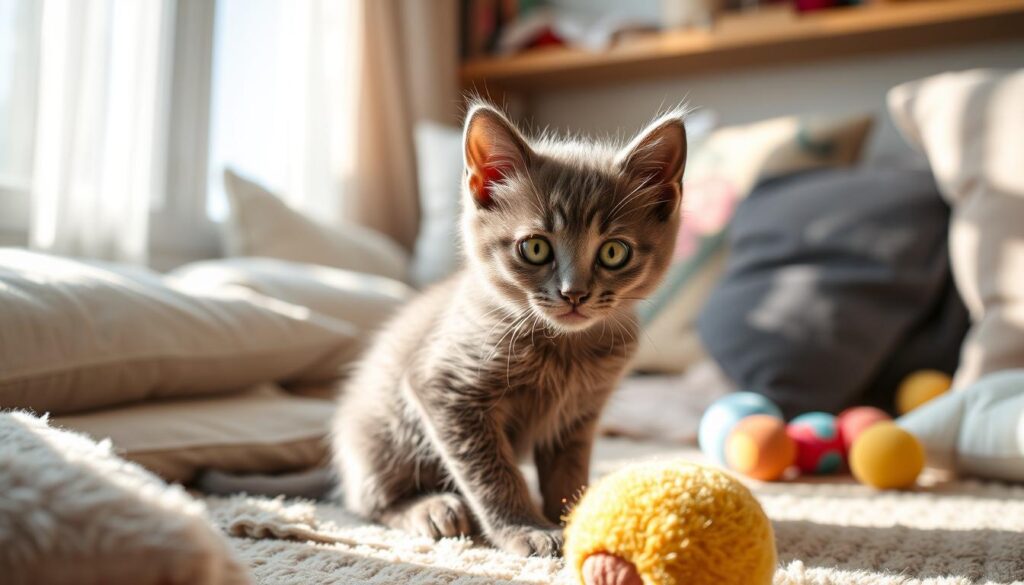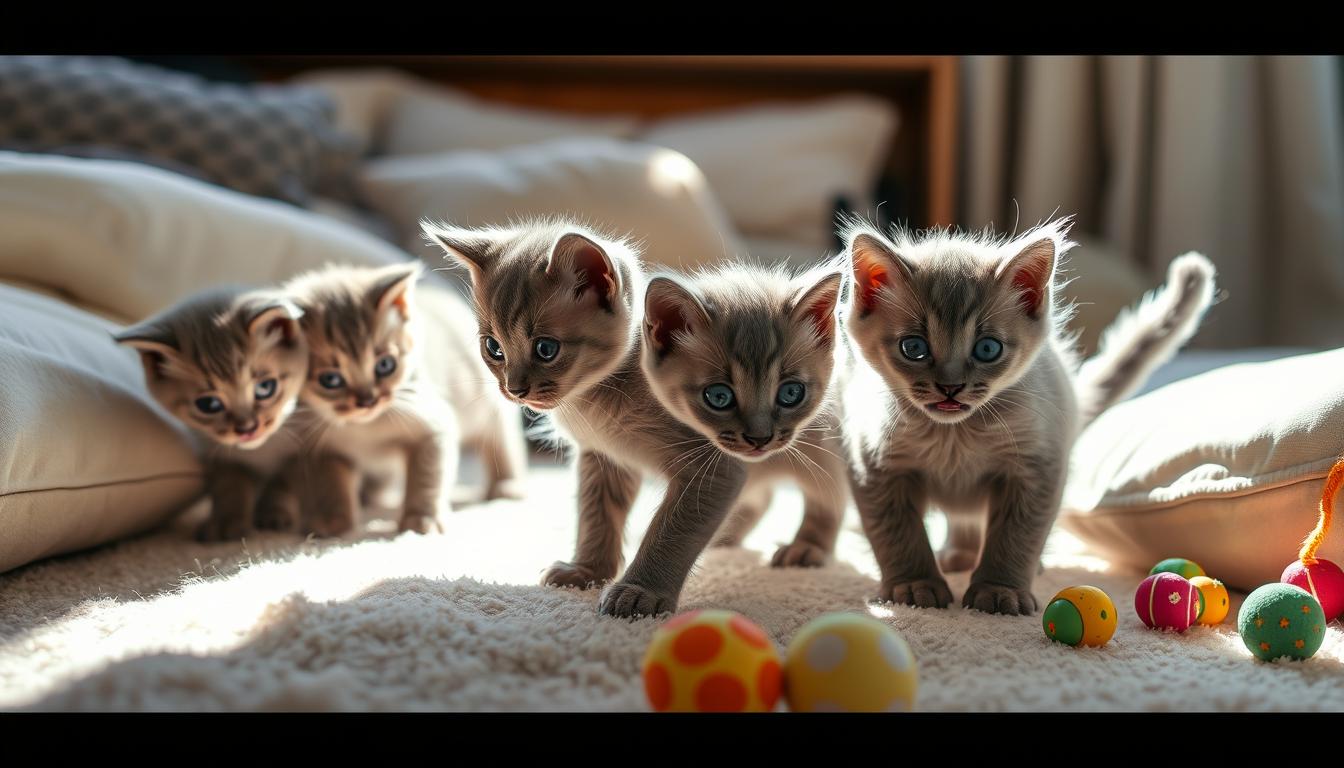Looking into a Russian Blue kitten’s eyes is magical. They have grace, intelligence, and love that wins hearts. Whether you’re new to pets or have had many, a Russian Blue can bring joy and adventure.
This guide explores the world of Russian Blue kittens. We’ll look at their history, looks, and care needs. These cats are loved for their beauty and loving nature.
Table of Contents
Introduction to the Russian Blue Breed
The Russian Blue is a captivating feline with a rich history. It has many desirable characteristics. This breed comes from Arkhangelsk, Russia, and was introduced to Western Europe in the 1860s.
It quickly became popular for its unique look and gentle nature.
Historical Origins and Heritage
The Russian Blue breed comes from cats kept by Russian Czars in the 19th century. These cats were loved for their beautiful silvery-blue coats and regal bearing. Over time, the Russian Blue became a distinct breed.
It’s known for its unique physical features and charming personality.
Why Russian Blues Make Perfect Companions
Russian Blue cats are known for their affectionate nature, intelligence, and loyalty. They make excellent companions for many households. They are also considered hypoallergenic, which is great for those with allergies.
They have a calm energy level and adapt well to different living situations. This makes them perfect for both first-time and experienced cat owners.
They live for 15-20 years and weigh 7-12 pounds. Their striking appearance, with a silver-gray coat and bright green eyes, is sure to captivate any cat enthusiast.
The Russian Blue’s beauty, affectionate temperament, and hypoallergenic qualities make it a great choice. It’s an excellent companion cat. With the right care, it can bring years of joy and companionship to its owners.
Distinctive Physical Characteristics of Russian Blues
Russian Blue cats stand out with their unique looks. They have a medium size and a silver-blue coat. Their eyes are emerald green, and their ears are large and pointed, making them look regal.
Their double coat is soft and dense, making them feel velvety. This texture is unlike other cats. Their build is muscular yet slender, with long legs and a tapered tail. They weigh between 8 to 15 pounds, with males being larger.
- Russian Blue cats have mauve or purple paw pads, a unique feature.
- They are known for their deep, striking emerald green eyes.
- On average, they are 10 inches tall, adding to their elegance.
Russian Blues are shy and reserved. They are among the most fearful cat breeds, especially around strangers. Yet, they are gentle, affectionate, and patient. They prefer to wait for attention rather than demand it.

These cats love to play alone with toys or objects. They are independent and curious. They also spend a lot of time grooming themselves, keeping their coats clean and tidy.
Russian Blue Kittens: Growth and Development Stages
Raising a healthy Russian Blue kitten is a journey. From birth to adulthood, they go through many stages. Each stage has its own milestones and care needs.
Newborn to 4 Weeks
In the first four weeks, kittens depend on their mom. They are born blind and deaf. It takes days for their senses to open up.
Newborns rely on their mom’s milk for food and warmth. They spend most of their time nursing and sleeping.
4 Weeks to 3 Months
At 4 weeks, kittens start to explore and play. They learn important social skills. This is a key time for their growth and behavior.
They begin to eat solid food and show their personalities. It’s a time of change and discovery.
3 Months to Adult
From 3 months to adulthood, kittens grow and refine their traits. They become more independent and active. They also strengthen their bond with their family.
This phase is about continued growth and learning. It’s when they become the unique and loving companions we adore.
Knowing the growth stages of a Russian Blue kitten is crucial. It helps you meet their changing needs. This ensures they grow into healthy, well-adjusted adult Russian Blue cats.
“Raising a kitten is like raising a child. Every stage is a new adventure, and each one requires patience, love, and a willingness to learn.”
Essential Care Requirements for Your Russian Blue
Having a Russian Blue kitten means you’re ready to be a responsible pet owner. These cats are smart and loving, but they need special care. This includes regular vet visits, the right food, and a fun environment.
First, taking your kitten to the vet is key. It helps catch health problems early. Good breeders test the parents and kittens for health issues like heart and eye problems.
Keeping your home clean and safe is also important. Make sure your kitten has a clean litter box, fresh water, and a fun place to play. Toys and scratching posts will keep them happy and active.
Grooming is vital for your Russian Blue. Their thick fur needs brushing to stay healthy. Don’t forget to trim their nails and brush their teeth to avoid health problems.
Feeding your kitten the right food is crucial. Talk to your vet about the best diet for your kitten. This ensures they grow strong and healthy.
By focusing on your Russian Blue’s care, you’ll give them a happy life. With the right care, they’ll be a loving companion for years to come.
| Breed Characteristic | Rating (1-5) |
|---|---|
| Family Friendly | 2/5 |
| Playfulness | 1/5 |
| Intelligence | 3/5 |
| Likes Other Pets | 4/5 |
| Grooming Needs | 1/5 |
| Shedding | 4/5 |
| Vocalization | 2/5 |

“Ensuring the health and well-being of your Russian Blue kitten is the foundation of responsible pet ownership. By diligently caring for their unique needs, you can provide your feline friend with a loving, enriching environment to thrive.”
Health Considerations and Common Issues
As pet owners, knowing about health issues in Russian Blue cats is key. These cats are usually healthy but can face certain problems. It’s important to watch for these and take care of them well.
Genetic Health Concerns
Russian Blues might get bladder stones and eye issues due to genetics. They are more likely to get bladder stones than other cats. They also face a higher risk of heart disease, which can be deadly if not treated right.
Preventive Care and Vaccinations
Regular vet visits and care are vital for your Russian Blue’s feline health. Make sure they get the right vaccinations. This helps catch problems early and keeps your cat healthy.
Regular Health Monitoring
As a responsible pet owner, watch your Russian Blue closely. Look for changes in eating, energy, grooming, or looks. If you see anything odd, see a vet fast. Early action can really help your cat’s health and happiness.
| Health Condition | Average Age of Onset | Prevalence in Russian Blues |
|---|---|---|
| Asthma | 4-5 years | Average |
| Atopy (Allergies) | 1-3 years | Average |
| Diabetes | Varies | Increased risk if obese |
| Aortic Thromboembolism | Any age | Can be fatal if not treated |
| Feline Infectious Peritonitis | Any age | Higher risk in purebreds |
| Bladder Stones | Any age | Increased risk compared to other breeds |
| Hyperthyroidism | 10-12 years | Average |
| Hypertrophic Cardiomyopathy | Any age | Increased risk |
| Kidney Disease | Senior years | Average |
| Obesity | Any age | Increased risk if not properly managed |
Knowing about health issues and acting early can help your Russian Blue live a long, happy life.
Feeding and Nutrition Guidelines
Proper nutrition is key for your Russian Blue kitten or cat. They need a diet rich in high-quality protein for growth and health. It’s important to feed them the right food at each life stage.
Feeding Kittens
Russian Blue kittens need a special kitten food until they’re about 12 months old. These foods are packed with nutrients to support their growth. They provide the vitamins, minerals, and calories kittens need.
Feeding Adult Cats
When your Russian Blue grows up, switch them to adult cat food. Look for a food that’s high in protein, moderate in fat, and low in carbs. Make sure they always have fresh water and watch their food intake to avoid obesity.
| Feeding Recommendations | Kitten | Adult |
|---|---|---|
| Recommended Diet | Kitten-specific formula | High-protein, moderate-fat, low-carbohydrate adult cat food |
| Feeding Frequency | 3-4 small meals per day | 2 meals per day |
| Portion Size | Adjust based on the cat’s age, weight, and activity level | Adjust based on cat’s age, weight, and activity level |
| Fresh Water | Always available | Always available |
Remember, proper kitten care and pet supplies are essential for keeping your Russian Blue happy and healthy. Consult your veterinarian if you have any questions or concerns about your cat’s nutritional needs.

“Feeding your Russian Blue a balanced diet is one of the best ways to support their overall health and longevity.”
Grooming and Maintenance Tips
Owning a Russian Blue cat is easy. They need little grooming, making them perfect for those who love pet supplies and cat grooming. Their short, dense coats just need weekly brushing. This removes loose hair and spreads natural oils, keeping their fur looking great.
Coat Care Essentials
Brushing your Russian Blue’s coat regularly is key. A soft-bristle brush or grooming glove once a week is enough. It helps manage shedding and keeps their fur in top shape.
Dental and Nail Care
Dental health is vital for your Russian Blue. Start tooth brushing and dental treatments early to avoid tartar and gum disease. Also, trim their nails every few weeks and give them scratching posts to keep their claws sharp.
| Grooming Frequency | Grooming Activity |
|---|---|
| Weekly | Brushing coat |
| Every 2-3 Weeks | Trimming nails |
| Daily | Tooth brushing |
Russian Blue cats are easy to care for and make great pets. With a simple grooming routine, you can keep your cat happy and healthy.
Training and Socialization Methods
Russian Blue kittens are smart and love to please. They can learn quickly with positive methods. Clicker training is great for teaching them basic commands and fun tricks.
It’s important to socialize them early. Let your kitten meet many people, animals, and places. This makes them confident and less likely to have behavioral problems.
- Start socialization as early as 3-4 weeks of age, gradually introducing new experiences in a positive, rewarding manner.
- Accustom your kitten to common household sounds, textures, and objects to help them feel secure in their environment.
- Encourage positive interactions with visitors, children, and other pets under close supervision.
- Provide ample opportunities for play and exploration to stimulate your Russian Blue kitten’s natural curiosity.
Training and socializing your Russian Blue kitten is key. They are smart and eager to learn. This makes training fun for both you and your kitten.

“Consistent training and early socialization are the keys to raising a well-behaved Russian Blue cat. With patience and positive reinforcement, you can unlock their full potential as loyal and affectionate companions.”
Creating the Perfect Environment for Your Russian Blue
Russian Blues love to play and explore indoors. They need a space that’s fun and safe. This ensures they’re happy and healthy.
Indoor Space Requirements
Russian Blues are full of energy and love to play. They need lots of room to climb, jump, and explore. Give them cat trees, scratching posts, and shelves for climbing.
Also, make sure they have cozy spots to hide. These places help them rest and feel safe.
Environmental Enrichment
Keep your Russian Blue’s mind and body active with fun pet supplies. Offer them toys like wand toys, puzzle feeders, and hide-and-seek treats. Change these toys often to keep them interesting.
Playing with your Russian Blue is key. It strengthens your bond and keeps them happy. Regular playtime is important for responsible pet ownership.
Make sure they can see outside through windows. This lets them watch birds and other wildlife. It’s fun for them and keeps their hunting instincts alive in a safe way.
With a well-designed, safe, and fun indoor space, your Russian Blue will be happy and healthy. They’ll be a loving part of your family.
Finding and Choosing a Reputable Breeder
When looking for your perfect Russian Blue kitten, finding a good breeder is key. They focus on the health, personality, and genetics of their cats. Look for breeders who are part of groups like The International Cat Association (TICA). This means they follow strict rules and act ethically.
A reputable breeder will tell you all about the kittens. They’ll share details like the kitten’s gender, personality, and how they’ve been socialized. They should also be open about the kitten’s health and their parents’ background. Visiting the breeder and meeting the kitten’s parents can show you how they’ve been cared for.
Think about adopting from a breed-specific rescue instead of buying from a breeder. These rescues often have Russian Blues looking for homes. The adoption fees are usually lower. No matter your choice, make sure you’re ready to care for your new pet.

